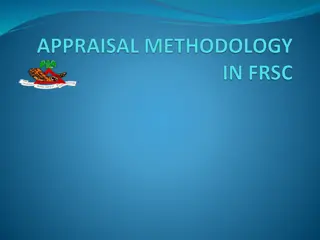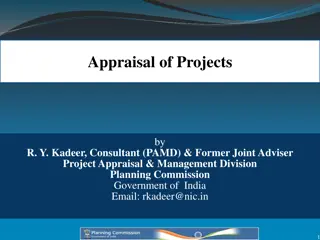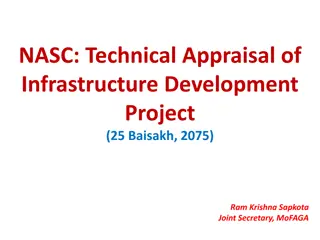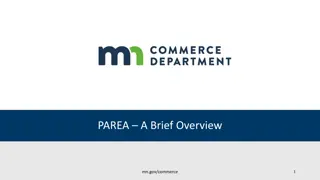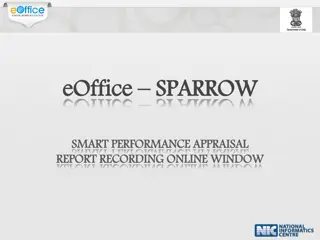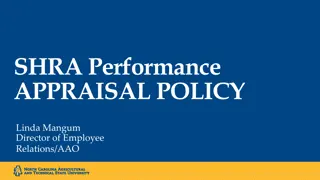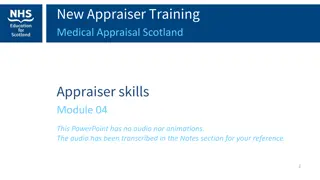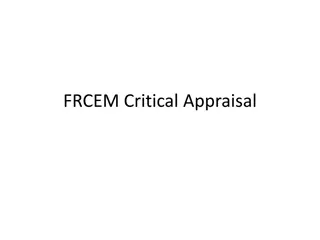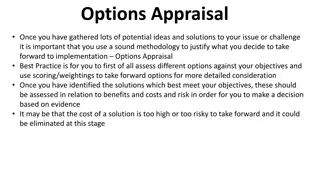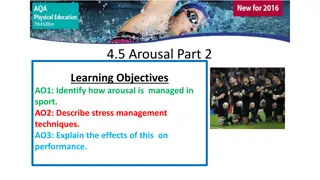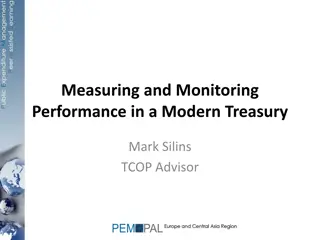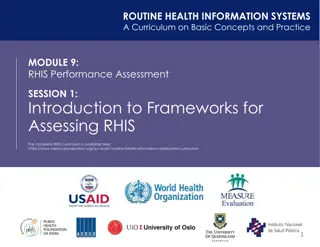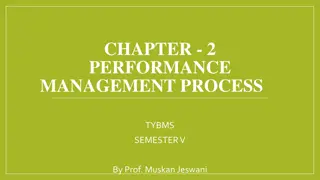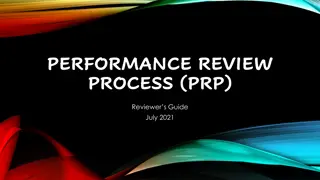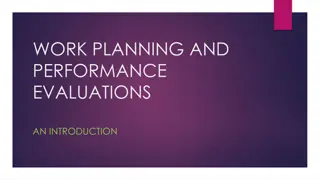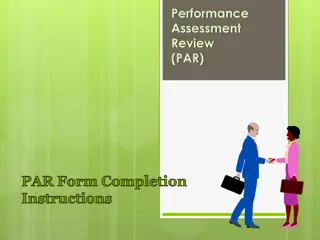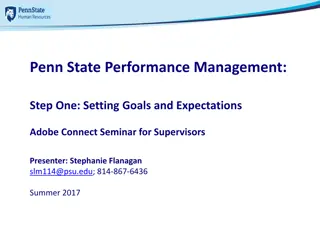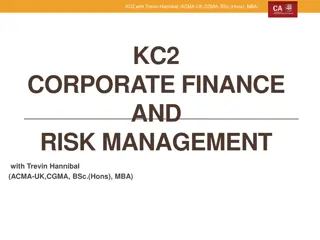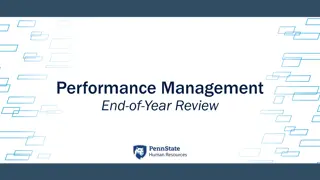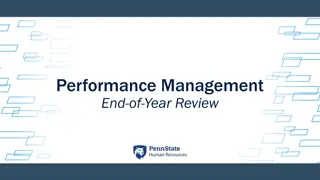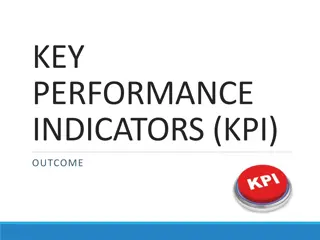Comprehensive Guide to Performance Appraisal and Management
Performance appraisal is a key process involving assessment, goal setting, feedback, and improvement strategies for individual and organizational growth. It includes setting benchmarks, assessing training needs, communication enhancement, and determining the effectiveness of HR programs like recruitment and training. The purpose of performance appraisal ranges from developmental and administrative uses to organizational maintenance and documentation. It serves as a competitive advantage and follows principles such as aligning corporate goals, emphasizing continuous improvement, fostering consensus over control, ensuring transparency, providing continuous feedback, involving all stakeholders, and simplicity in design.
Download Presentation

Please find below an Image/Link to download the presentation.
The content on the website is provided AS IS for your information and personal use only. It may not be sold, licensed, or shared on other websites without obtaining consent from the author. Download presentation by click this link. If you encounter any issues during the download, it is possible that the publisher has removed the file from their server.
E N D
Presentation Transcript
PERFORMANCE APPRAISAL and MANAGEMENT
Performance Appraisal is an objective assessment of an individual s performance against well defined benchmarks. Relationship between Performance Appraisal & Job Analysis
Shift in Performance Management Outlook
Objectives-Performance Appraisal To effect promotions based on competence and performance To confirm the services of probationary employees upon their completing the probationary period satisfactorily To assess the training and development needs of employees To decide upon a pay raise where (as in the unorganised sector) regular pay scales have not been fixed To let the employees know where they stand insofar as their performance is concerned To improve communication Can be used to determine whether HR programmes such as selection, training, and transfers have been effective or not
Purpose- Performance Appraisal 1. Developmental uses 2. Administrative uses/ Decisions 3. Organisational Maintenance 4. Documentation
Performance Appraisal as Competitive Advantage
Principles of Performance Management Corporate goals are translated into individual, team, departmental and divisional goals It should not be linked with only financial rewards Performance improvement is an ongoing process and improves over time Consensus and co-operation needed, not control and coercion Transparency is needed at every stage Continuous feedback is essential It should cover all employees It is a system and not a piece of work Make it simple and easy Involvement of all stakeholders in designing formats, policies and procedures is needed
Appraisal Process 1. Objectives:
Appraisal Process 2. Establish Job Expectations 3. Design Appraisal Programme
Appraisal Process Problems of Rating: Leniency/Severity Central Tendency Halo Effect/ Horn Effect Primacy/ Recency Effect Stereotyping/ Perceptual set Spillover Effect Status Effect Other errors- like, error of wishful thinking Read Exhibit 9.2
Appraisal Process Solution to Raters problems: Factors that help improve accuracy: The rater has observed and is familiar with behaviours to be appraised The rater has documented behaviours to improve the recall The rater has a checklist to obtain and review job-related information The rater is aware of personal biases and is willing to take action to minimise their effect Rating scores by raters of one group or organisation are summarised and compared with those by other raters The rater focuses attention on performance-related behaviours over which the rater has better control than in other aspects of evaluation
Appraisal Process Factors that help improve accuracy: Higher levels of management are held accountable for reviewing all ratings The rater s own performance ratings are related to the quality of rating given and the performance of units Performance factors are properly defined Factors that may lower accuracy: The rater rates ratees only when administrative actions are contemplated The rater tends to inflate ratings when the ratees receive scores and results of appraisals The rater tends to recall more behaviours known to be of particular interest to higher-level managers The rater is unable to express himself or herself honestly and unambiguously Appraisal systems, processes and instruments fail to support the rater The rater is unaware of causes of rating errors The rater has to rate employees on factors that are poorly defined
Appraisal Process What should be rated?? Quality, quantity, timeliness, cost effectiveness, need for supervision, interpersonal impact & community services. e.g. Mind Tree Consulting- CLASS
Appraisal Process Timing of evaluation?? Methods of Appraisal: 1. Past Oriented methods 2. Future Oriented methods
Appraisal Process: Past Oriented Methods 1. RATING SCALE/ GRAPHIC RATING SCALE
Appraisal Process: Past Oriented Methods 2. CHECKLIST METHOD
Appraisal Process: Past Oriented Methods 3. FORCED CHOICE METHOD
Appraisal Process: Past Oriented Methods 4. FORCED DISTRIBUTION METHOD
Appraisal Process: Past Oriented Methods 5. CRITICAL INCIDENT METHOD
Appraisal Process: Past Oriented Methods 6. BEHAVIOURALLY ANCHORED RATING SCALE
Appraisal Process: Past Oriented Methods 7. PAIRED COMPARISION
Appraisal Process: Past Oriented Methods 8. Performance Test & Observation 9. Confidential Records 10. Essay Evaluation 11. Ranking MethoD
Appraisal Process: Future Oriented Methods 1. Management by Objjectives (MBO) 2. Assessment Centres 3. Psychological Appraisals 4. 360 degree feedback
Performance Management Performance appraisal only gives feedback More is required in addition to this: 1. Performance interview 2. Archiving performance data 3. Use of appraisal data
Performance Management- Performance Interview Guidelines for Effective Appraisal Interview Select a good time Minimise interruptions Welcome, set at ease Start with something positive Ask open-ended questions to encourage discussion Listen Manage eye contact and body language Be specific Rate behaviour, not personality Layout development plan Encourage subordinate participation Complete form Set mutually agreeable goals for improvement End in a positive, encouraging note Set time for any follow-up meetings
Performance Management- Archiving Performance Data Organisations need to store the appraisal data so that at any point in future the information can be retrieved and used.
Performance Management- Use of Appraisal Data In one way or another, data and information outputs of a performance-appraisal programme can critically influence these coveted employer employee reward opportunities. Specifically, the data and information will be useful in the following areas of HRM: Remuneration administration Validation of selection programmes Employee training and development programmes Promotion, transfer and lay-off decisions Grievance and discipline programmes HR planning


